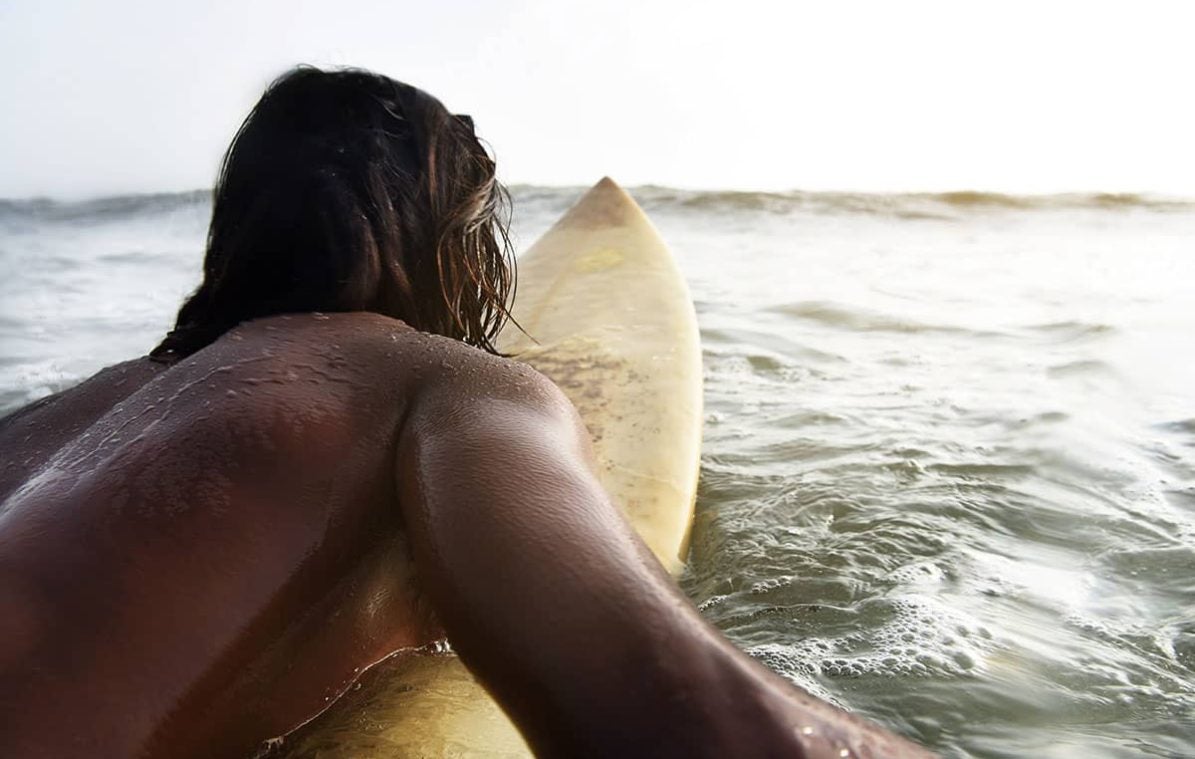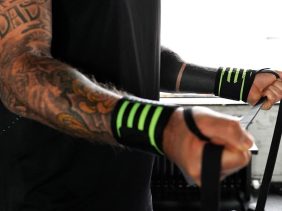If you want to learn how to surf, these 11 tips will help you get started
 © Robin Skjoldborg
© Robin Skjoldborg
Let’s be honest, surfing isn’t only an effective full-body workout, it also looks really cool. That is, if you can actually do it! Surfing skills don’t come overnight, and you need to do a lot of training to really master the board and the waves. But believe us when we say that just the feeling itself that you get from surfing makes it worthwhile. So that you’re best prepared for it, here are our 11 most helpful tips for starting your surfing training.
Also worth reading: 7 Surprising Reasons Why You Should Start Surfing This Summer.
What You Need To Know As a Beginner
To make sure that you quickly cut a good figure on your board, you should follow these 11 tips:
#1 Get a Board That’s Right For You
If you want to learn how to surf, then the first thing you need is a good surfboard, of course. Boards known as Mini Malibus or funboards are suitable for beginners. Unlike other boards, they have a rounded shape, which provides you with more stability while surfing. Their higher volume also makes padding and planing easier for you. Softboards are also highly recommended, especially for beginners. They also have a lot of volume and, as the name suggests, feature a softer surface. This minimizes the risk of injury.
#2 Choose the Right Surfing Spot
For beginners, low tide is the best time, as the waves then are usually gentler and last longer. Find out in advance which beach is suitable for beginner surfing. Once you get there, start by getting an overview: Where are the surfers who are sitting on their boards, waiting for the perfect wave? That’s the spot for professionals. The best place for you to start is the one where a surf school is giving a class or where other beginners are practicing in the white water. In the beginning, you should only go out if there are other surfers in the water whom you can use as guidance.
#3 Assess the Danger Of the Surfing Conditions
The power of the sea should not be underestimated. That’s why you should get an overview of the conditions at the beach beforehand; for example, by asking in a surf shop. Take the following things into account:
- Reefs and rocks
- Currents
- Surf
- Other water sports athletes
- Animals
- How cold the water is
#4 Warm Up Before You Hit the Water
Surfing is a challenging endurance and strength sport that works your whole body, so you should warm up before a surf session at the beach. This prepares your joints, ligaments, and muscles for the stress. Your focus should be on your spine, hips, hamstrings, and shoulders. Simple exercises for your warm up include:
- World’s Greatest Stretch: Start in a push-up position, then place your left foot next to your left hand. Pressing your right hand into the ground, turn the left side of your upper body upwards, stretching your hand towards the sky. Then bring your left elbow to the inside of your left foot and turn yourself upwards again.
- Cat-Cow: To stretch and flex your spine, get onto all fours and alternate between rounding and arching your back. Be sure to perform the movement with your entire spine.
- Deep Squat: Mobilize your hips and ankles by getting into a deep squat. Press your palms together, then press your elbows lightly against the inside of your knees. If your heels lift off the ground, you can put something underneath them, such as a rolled up towel.
- Downward Dog: This is the perfect pose for warming up your shoulder girdle, hamstrings, and ankles. You know this one from yoga. You can make the exercise dynamic by repeatedly pushing yourself back to the starting push-up position.
#5 Practice On Land and In White Water
Before you venture further out into the lineup, you should familiarize yourself with the board and the water. To this end, first practice on dry land, then closer to the beach in the white water. This is the area where the waves have already broken and the foamy white water is flowing toward the shore. Depending on the surfing area and the current weather conditions, the white water has enough power to propel you forward. Lie down on your stomach on your board and paddle behind the waves. Turn the nose of the board toward the beach so that the wave comes head-on from behind. If this goes well, you can make your first attempts at standing up in white water.
#6 Learn To Paddle
Surfing means one thing above all else: paddling! In order to arrive at the lineup as quickly and energy-efficiently as possible, you should learn the correct paddling technique as soon as possible. Here’s how you do it:
- Lie on the center of the surfboard so that your feet stick straight out over the end of the board.
- Tense the muscles in your body and straighten your torso slightly, similar to the Cobra pose in yoga.
- Direct your gaze toward a point in the water in front of you.
- First dip your fingers at a 45-degree angle, then alternate your arms deep under water and forcefully bring your hands from the nose of the board to about chest level.
- This is how you execute long, powerful paddle strokes. Breathe in and out evenly.
#7 Dive Under the Waves
Paddling out means negotiating some waves. To prevent the surf from washing you right back onto the beach, you have to avoid it. Paddle fast and head-on toward a white water front. For small waves, you can push yourself up into a push-up position . To do this, hold on to the sides of the board and push your chest up. If the waves are bigger, push the nose of the board under water and dive under the leading edge.
One important thing to remember is never to paddle directly behind another surfer. If the person in front is knocked over by a water torrent, dangerous collisions can easily occur.
#8 Find the Perfect Wave
Once you’ve arrived at the lineup, keep your eyes open for the perfect wave. Here’s what to look for when considering if it’s worth paddling toward:
- The wave hasn’t broken yet.
- The wave is not too flat and not too steep.
- The wave has a recognizable peak – that’s where it starts to break.
- You are at the height of the peak.
- You have little or no competition on the water. There should not already be several surfers paddling toward the wave.
In the beginning, don’t think too much about the perfect wave. You’ll get a good feel for it over time. Until then, only practicing will make you a pro.
#9 Plane Toward the Wave
To paddle, position your board at a right angle to the wave. Take a stable starting position on the board, tense the muscles in your body, and start paddling forcefullyas soon as the wave is only a few meters away. The aim is to have the same speed as the approaching wave. As soon as you feel that the wave has caught you, do two to three more paddle strokes and push your chest up a bit more to prepare for your take off.
#10 Stand Up On Your Board
Now it’s getting serious. The motion of getting up on the surfboard is also called a pop up . So that you can master standing up, you should practice the movement sequence, first on land, then in white water.
- Paddle until you feel your board being caught by the wave.
- Place your hands flat on the board at chest level and push yourself upwards into a hollow back pose.
- Pull your lead foot forward, press your palms and back foot firmly into the board, and bring your front foot between your hands.
- Stand up in a controlled manner and use your arms to maintain your balance.
- Continue to look in the direction that you are moving and bend your knees slightly.
#11 Get Used to Falling
You should also practice falling off of the board, which is called wiping out. That’s because you’ll be doing this “maneuver” a lot while you’re surfing. To avoid injuring yourself, the most important things is to stay calm. Let yourself fall flat into the water and hold your arms protectively over your head. While you’re being whirled about by the water, relax your muscles and let yourself float to the surface. Don’t panic, and then get your bearings when you break the surface again. Collect your surfboard and paddle back out again without obstructing other surfers.
The original text was revised on 7/19/2022 by Natascha Klemm.
More interesting articles from foodspring:
- 7 Things You Need to Know to Start Windsurfing
- The Best Activities for a Healthy Beach Vacation
- 5 surprising reasons why swimming is good for you
Sources for this article
We at foodspring use only high-quality sources, including peer-reviewed studies, to support the facts within our articles. Read our editorial policy to learn more about how we fact-check and keep our content accurate, reliable, and trustworthy.






















